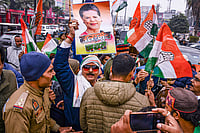The possible hindrance to the studies of Shi'ism in Kashmir has been the continued emphasis on the geographical heartland of Shi’ism in West Asia and Awadh in South Asia. Given the paucity of works on South Asian Shi'ism, the region of Kashmir hardly receives much attention in any major academic work on Shi'ism. Shi’ism in Kashmir: A History of Sunni-Shia Rivalry and Reconciliation by Hakim Sameer Hamdani is a ground-breaking study of Kashmir's Shi'is, and it will help pave the way for future studies in this field. This book is primarily concerned with the period between the 18th and 19th centuries in Kashmir. With a brief description of the events before that, the book deals with the sectarian politics and identity formation of Shi'is in Kashmir and how later, once a homogenous group, they saw internal divisions. The book also examines the circumstances and events that led to the easing of sectarian tensions.
Earlier studies on the subject, such as Islam and Shia’s faith in India (1953) by John Norman Hollister and The Shia’s of Pakistan (2015) by Andreas Reick, trace the existence of Shi’ism in Kashmir with the arrival of Mir Shamsuddin Iraqi (d. 1525), others like Athar Abbas Rizvi's work A socio-intellectual history of the Isnā ‘Asharī Shi'is in India (1986) traces this to Syed Mahmud of Sabzwar (Iran) and the party of Bayhaqi sayyids. However, these arguments clash with the one presented by Hamdani to this discussion by citing a Shi’i Hadith book, Al-Kafi, by Muhammad Yaqub al-Kulayni that describes a meeting between Abu Said Hindi and the 12th Shi’i Imam al-Mahdi in Baghdad around the year 877 CE, which indicates the earliest Shi’i presence in Kashmir.
The reason that the earlier literature regarded Shamsuddin Iraqi as a seminal figure who introduced Shi’ism in Kashmir is that he is the one, Hamdani argues, who brought Kashmiri Shi’i from the margins into the centre of power and patronage. He also served as the spiritual leader of the Shi’i rulers, Chaks, who ruled Kashmir from 1561 until 1586. This book's author, Hakim Sameer Hamdani, is an architect and conservationist who wrote his first book "The Syncretic Tradition of Islamic Religious Architecture of Kashmir (Early 14th–18th Century)". As a result, this book represents a significant shift in his area of interest, yet it appears promising and essential for the advancement of research in this field.
Comprising five chapters, Hamdani begins the book by talking about the Kashmiri Dapan (lit. It is said) tradition. Orality is a very important part of the Kashmiri language and is at the heart of the Kashmiri Dapan tradition that develops from it. The author has applied critical lenses to this tradition of Dapan, which has sectarian biases that emerge from Sunni circles, and questions how this everyday tradition, whose origin is folklore, acts as a self-authenticating instrument of history. This everyday tradition has created stereotypes and dehumanised the Shi’i; these stereotypes were so popular that they even got mentioned in the travelogues of European travellers.

Countering the popular narrative on Kashmiri history and the exploitation of religion for achieving political ends, Hamdani tries to expose the bias of historians and their narrative, particularly that of Azam Dedhmari, whose historiography is heavily influenced by the anti-Shi’i Sufi Sheikh Hamza Makhdum and company. In the writings of succeeding scholars, Dedhmari's anti-Shi'i narratives maintain a firm hold. This diligently researched work also brings out the reason for sectarian conflict in Kashmir within the politics of the khanqah and court, where Sufis are enablers of sectarian politics in order to acquire factional supremacy.
The history of Kashmir from the middle of the 16th century to the late 19th century was characterised by Shi’i persecution and oppression, which is infamously known as Taraj-e-Shi’i, or what Kuihami discussed in his Tarikh-e-Hasan as the Ten Major Taraj (massacre). According to Hamdani, the Afghan era, which spans from 1752 to 1820, looks to be the most repressive in Kashmiri Shi’i history because any outward manifestation of Shi'iness is greeted with heavy punishment from the authorities. Imam Husain's martyrdom was commemorated in secret under taikhanas; even the Kashmiri marsiya (lamentation of the dead) depicts a sense of individualised grief and sorrow rather than the bravery and heroism and romanticised depiction of battle that can be found in the Urdu marsiyas of the same era, particularly in the marsiya of Meer Anees and Mirza Dabeer, the genre’s legends.
As Eve Tignol argued, "The emotional dimension of memory is precisely what gave power to it." The author illustrates the centrality and importance of grief and emotion as they are expressed in the Kashmiri marsiya as a tool in imagining and creating solidarities among muminin (Shi'i) and how marsiya writers evoke the memory by employing emotional styles by comparing their suffering with that of the tragedy of Karbala. The author highlighted this by saying, "If the marṣiyas are evaluated within the prevailing sociopolitical conditions, one would see in them an assurance to the historically aggrieved and powerless Shiʿi community that their sufferings are a reflection of those at Karbala and the reward of faith lies in the hereafter". (p.40)
It is perhaps odd to think that the Afghan administration, which was characterised by sectarian prejudices against Kashmiri Shi’i, ironically, at the same time, Iranian Shi’i shawl merchants were exempt from these prejudices or received some sort of indemnification from the subedar. This, according to Hamdani, is due to the significance of the Shawl trade to the Kashmiri economy. These Shi’i merchants were also quite active in civic, governmental, and political matters.
The book reveals to us the notable presence and influence of the Kashmiri Shi'i diaspora, particularly within the kingdom of Awadh. The presence of Kashmiri Shi’is may be traced back to the early years of Awadh's formation, but the biggest influx took place during the Afghan era, which saw the arrival of ulema, poets, and marsiya writers, among other notables. Shi’is were persecuted during the Afghan era, making relocation a viable choice for the elite into Awadh, one of the most powerful Shi’i kingdoms in the modern world, where their scholarships get courtly patronage. After the riots of 1830 in Srinagar, people of Kashmiri descent who held prominent administrative positions in the neighbouring Awadh kingdom assisted in the rehabilitation of the populace and the reconstruction of Marak (place of mourning for Imam Husain, Imambada) at Zadibal.
The Sikh empire ended Muslim rule in 1819, leaving the Sunni community feeling dispossessed. The work of Kashmiri Persian poet Mulla Mahdi Mujrim, whose work Shaher-Ashub (the city's misfortune) represents the lament of the Muslim past, is mentioned by Hamdani in reference to the confiscation of jagirs, the closure of Jamia Masjid, and the threat to Khanaqah-i-Maula that followed the annexation of Kashmir by the Sikh forces.
On the other hand, Shi’is used this opportunity to openly proclaim their identity vis- a -vis the Sunni majority. They not only articulated their public expression related to mourning but also started asserting rituals and practises that made their distinction visible. However, the commemoration of Imam Husain's martyrdom is at the heart of this identity project, and the author highlights that the institutions of Muharram, marsiya, and Marak were central to this Shi’i revival approach.
The long nineteenth century can be described as the most tumultuous century in Kashmiri Shi’i history, as this century witnessed a plethora of events ranging from anti-Shi’i riots at the start
of the century, which is indicative of the attempted assertiveness of the community under Afghan rule, but later this assertiveness became visible as Shi’is started reclaiming their public space under non-Muslim rulership. Until this period, the imagination was homogenous, but subsequently, this unified identity started to break down, and the cracks came from within.
While acknowledging the historically homogeneous nature of the community, the chapter on "dissension within the mumin" contains a multitude of insightful information. It details how this consolidated identity began to show signs of churning from the 1850s onward with the issue of Marak custodianship and the initiatives of the Iranian cleric Sayyid Ibrahim's introduction of congregational prayer and waiz khani (preaching) in Marak that provoked opposition from the Marakdar and community elites. Firqa-i-Qadeem (the old group) and Firqa-i-Jadeed (the new group) were the two main groups that emerged from the struggle to control Marak. The second point of dispute was the division of Khums (obligatory religious tax) between Mousavi and Rizwi sayyids. The author also briefly notes other problems, including the caste and class system that the community was enmeshed in, without going into further detail. However, these problems were not so severe that they would have eventually caused the community to disintegrate.
Since their inception, Firqa-i-Qadeem and Firqa-i-Jadeed have taken differing stances on a variety of social phenomena, including sectarian relations and modern education. Syed Mahdi's visits to the significant Sunni shrines of Dastgir Sahib and Sheikh Nur al-Din were the first significant visits by a Shi’i cleric, which are indicative of a different approach of Firqa-i-Jadeed to community relations with the majority Sunni community. There has been a mixed reaction among Shi’is to modernity and missionary activity in Kashmir. Firqa-i-Qadim was sceptical of missionary education and had a negative view, while Firqa-i-Jadeed was more receptive to missionary institutions. Scholars like Moulvi Haider supported fusing modern education with traditional Muslim values.
In the early 20th century, Kashmiri Shi’i also witnessed the formation of new organisations that aspired to work for the social welfare and well-being of the community. These organisations were established by people coming from different backgrounds, like Anjuman-i-Imamia and Hami al Islam, which were established by clerics, while Shi’i Upliftment Association (est. 1930) and Anjuman-i-Bahbudi Shiyan-i-Kashmir (est. 1932–4) had a non-clerical background. This reflects the changing dynamics of power within the Shi’i community.
Coming to the issue of sectarian relations, when non-Muslim power prevailed, there was a notable pause in polemical discourse, and according to Hamdani, a change in communal sentiments began to emerge. He draws attention to the way that historians refer to Sunni and Shi’i as Muslims, which amplifies the way that Shi’is are included in the Muslim categories. Nevertheless, Hamdani insists that despite these limits to the achievement of an ecumenical community in the 20th century, Muslims have presented a unified front against Hindu Dogra rule.
The final part of the book gives reference to the improvement in sectarian relations in early 20th-century Kashmir, which is a positive development and a sign of detente between the two communities. The first was a memorandum to Lord Minto in 1907 that was signed by leaders from both the Shi’i and Sunni faiths, portraying both as part of a single, integrated Muslim community. The second one, Ashura of 1923, is the pivotal event in Shi’i history because it was the first time the Ashura procession took place during the day, defying the established routine. However, the next Muharram, this practice was outlawed. Disobeying the order, the Shi’i took procession, and as a result, the taziya was confiscated. But this time, Shi’is were supported and accompanied by the Sunni community.
The book is thoroughly referenced and uses a variety of primary and secondary sources, including historical books in Persian, Urdu, and Kashmiri and archival as well as family texts. The author validates his narrative by analysing the event from diverse sources, including Sunni and Shi’i accounts as well as non-Muslim accounts and, occasionally, traveller's accounts of the event, before coming to any conclusion. For instance, the 1830 riot is looked at using the Sunni accounts of Marjanpuri and Kuihami, as well as the account of European tourist Vigne, who visited Kashmir in 1835.
Hamdani's work succeeded in providing an overview of sectarian conflict and reconciliation by locating them in the domain of community elites. The limitation of Hamdani’s book likely stems from his insufficient attention to the caste and class divisions among Shi’i as well as Shi'i women's perspectives. Shi’ism in Kashmir opens space for further research and the implications of his argument for this larger and crucial project of Sectarian relations in Kashmir and how it defines and redefines identities. Shi’ism in Kashmir’s epilogue closes on a positive note for South Asia in general and Kashmir in particular.
(Mohammad Wali Akhtar is a Master's student at the Department of Political Science, Jamia Millia Islamia University, New Delhi.)





















